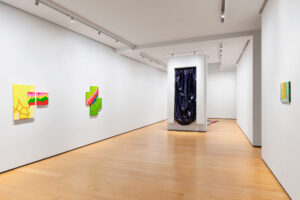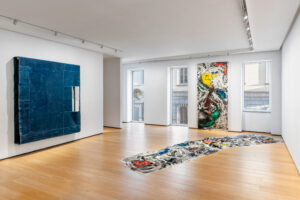A small-big gem, curated by Chiara Bertola and Davide Ferri, can be visited at Building Gallery in Milan. The exhibition in question, Glitch, is housed in the gallery’s beautiful structure where every work, even those not specifically designed for this reason, seems site-specific. Glitch, “an onomatopoeic term generically denoting the short-lived disturbances that occur in a teletransmitted impulse, deforming its waveform”, as the Treccani encyclopedia tells us, is a displacement in the regularity of things. The artworks by the ten featured artists are thus presented as rips – of reality, of painting – revealing another conception, as entrances to another dimension. The artists, which are Italian and international, from different ages and backgrounds, derive their research from the 1960s, when painting begins to deny narrative, for a full “objectivity” of vision, which also allows for the development of new, unconventional methods of doing painting.

Ground floor, from left to right: Splashy Cut, Firey Pour by Mary Heilmann, Stuck (Blue) by Angela de la Cruz, Empty Walls 88 by Farid Rahimi. Photo Leonardo Morfini, courtesy Building Gallery
At the entrance we are greeted by two works by Mary Heilmann (1940), Splashy Cut and Firey Pour, unscrupulously American in color and form, also derived from the artist’s decorative practice, which dialogue with Farid Rahimi‘s (1974) Empty Walls 88, with a distinctly European neo-plastic flavor, almost in stark contrast to the former. The latter’s pure but truly glitchy walls seem to open us up to Heilmann’s colorful glimpses. The star of the room, in a leitmotif that is repeated on all three floors, is the majestic industriousness of Stuck (BLUE), a work by Angela de la Cruz (1965). A canvas suspended between painting and sculpture: it attracts the eye, touch and sense of smell making this work a true catalyst. Circumnavigating Stuck, we find a site-specific Untitled by Andrea Kvas (1986), another true mystery lake, black hole, spatiotemporal continuation of both the Building Gallery and the artist’s work, who, around the large cosmos that seems to invite us to immerse ourselves in the work, located on the floor, leaves his tools and the materiality of his process. Concluding the first area there are Charles Rosenthal, Im Park 1930 by Ilya (1933-2023) and Emilia (1945) Kabakov, with a masterfully executed almost Impressionist scene from which the illuminated frame reveals the deception of the painting. Then we find Maria Morganti‘s Gemmazione No. 5 (1965) and Simon Callery‘s Rural Wallspine (1960), which bring us back to the temporal and repetitive dimension of the production of the artwork.

Foreground, from left to right: Blue painting (Ravenna) by Simon Callery, Untitled (Industrial Painting) by Pinot Gallizio. Photo Leonardo Morfini, courtesy Building Gallery
The second floor opens with Pittura industriale, in name and in fact: three large untitled canvases produced in the late 1950s by Pinot Gallizio (1902-1964) masterfully displayed, both on the wall and on the floor, do justice to the grandiosity of the work. It is from this glitch that the exhibition’s grand arrangement comes to life, in the situations of experimentation that characterize the decade between the 1950s and 1960s in Italy, in the great family of informal painting. Dialoguing with Gallizio, again Maria Morganti with Uno alla volta, a work composed of several canvases and exhibited as if they were a sampler-always echoing the explicit industriality of the room, and by Simon Callery’s Blue Painting (Ravenna) (1960): between the sacred and the profane it recalls the blue of the Ravenna mosaics but also Blue Jeans. Hidden, Farid Rahimi’s Screen Room 14 is revealed, inserted at the end of a small corridor, where all perspective lines converge with the lines of the painting, creating a metaphysical atmosphere.

Second floor, from left to right: Keep on moving, As birds feel shadow by Peggy Franck. Photo Leonardo Morfini, courtesy Building Gallery
The top floor is dedicated to two great artists, Peggy Franck (1978) and Alejandra Seeber (1969). Seeber “takes” a large space in the front wall. Not only that, she decides to play with it and with us, highlighting the grid of the wall, as if highlighting the code of the Matrix in which we are inserted and embedded, having fun breaking it and relating the works exhibited inside or outside of it. Forest Fabric, Bricks, No Logo, Cascade of Color, Yester Memories, Knitt Green and Pink: these are the titles of the works that within them, again, bear a code: this time one reminiscent of a large knit. Instead, Peggy Franck demonstrates a remarkable elasticity of works and media. Always characterized by her fresh brushstrokes, for the second floor the large third industrial work stands out, this time a magnificent carpet print, as birds feel shadow, which stretches from the ceiling to our feet. It is mpressive the effect of Keep on moving, a photo of an earlier work of her with a stunning perspective effect. The artist pays homage to the gallery with two site-specific works, Your Smell, in my hair, painted on the wall and MM MM MMMM, painted on a semi-reflective paper and placed in front of a window. Looking at it, below the brushstrokes we are reminded that an outside world still exists. But that it can be torn apart, seen in a million different ways. Glitch.
Claudia Corso Marcucci
Info:
AA.VV. Glitch
8/11/2023- 27/01/2024
Building Gallery – via Monte di Pietà 23, 20121 Milano
www.building-gallery.com

is a contemporary art magazine since 1980






NO COMMENT